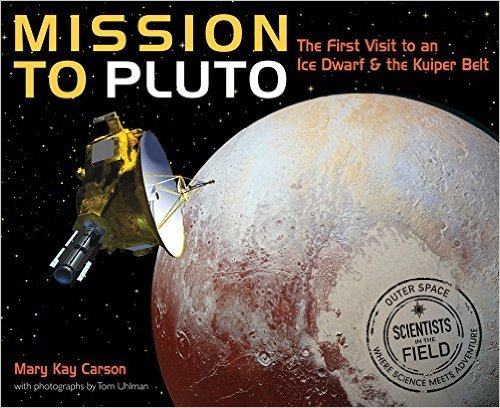In the old days, the usual practice for teaching the solar system was to have kids make models of the planets and suspend them from the classroom ceiling at varying distances from the sun that had nothing to do with scale. Motion (mass) and gravity--the primary forces that allow the solar system to exist were hardly mentioned, let alone considered deeply. Mary Ann Carson's new book Mission to Pluto: The First Visit to an Ice Dwarf and the Kuiper Belt, with photographs by Tom Uhlman is an adventure story of sending a spacecraft, named New Horizons, to the dark edge of the solar system to see what we could see. One result: Pluto is no longer considered a planet. It has a new name, a "dwarf" planet, and its largest moon, Charon, is almost as big. Instead of orbiting Pluto's center of gravity, it circles a spot in space outside of Pluto! It's almost a double planet! There are also four other moons. So don't think that Pluto has been demoted, it is a system all unto itself--the largest group of orbiting ice and rocks called the Kuiper Belt.
So, what did it take to fly by Pluto? First it took a dreamer, Alan Stern--the lead investigator of the team that designed, built and flew New Horizon. Then it took a team of astronomers, planetary scientists, engineers and technicians. (Don't forget funding.) Then it took time--it was launched from earth on January 19, 2006 and arrived to fly by Pluto on July 14, 2015, more than nine years later. Alan Stern said it took "patience and persistence" to get to Pluto. What was that moment like?
"More than one face shone with tears. It was a historic moment after all. The fastest space craft ever to leave Earth had just completed the farthest voyage to a target destination and become the first ever to explore Pluto. The small robotic probe on the computer screen didn't pause during all the hoopla. After traveling 3 billion miles for nine and a half years, its focus was on Pluto.....This was the prime time for taking measurements, scanning the surface, and snapping close-up photos. New Horizons was flying its closet pass by Pluto. It had work to do."
The New Horizons passed by Pluto at 7:45 in the morning and sent back a photo several hours later but no one would see its images until 9 pm that night. What they discovered did not disappoint.
Carson's Mission to Pluto, a new entry in the "Scientists in the Field" series, is a thrilling narrative that requires readers to learn concepts and terminology as they go. Young readers have proven that they love doing this when reading Harry Potter. So why not have them read about an alternate universe that is a real alternate universe? There is genuine romance here--scientists in love with exploring the unknown. You feel the romance in this book. There is only one catch, if you want to be a player in this kind of drama, you need skills in STEM subjects that require diligence and study to acquire. Educators know that the key to learning is motivation. Carson and Ulhman's Mission to Pluto does this far more effectively than papier-mâché models of planets with lists of facts (many of the obsolete by now) hanging from the ceiling.

